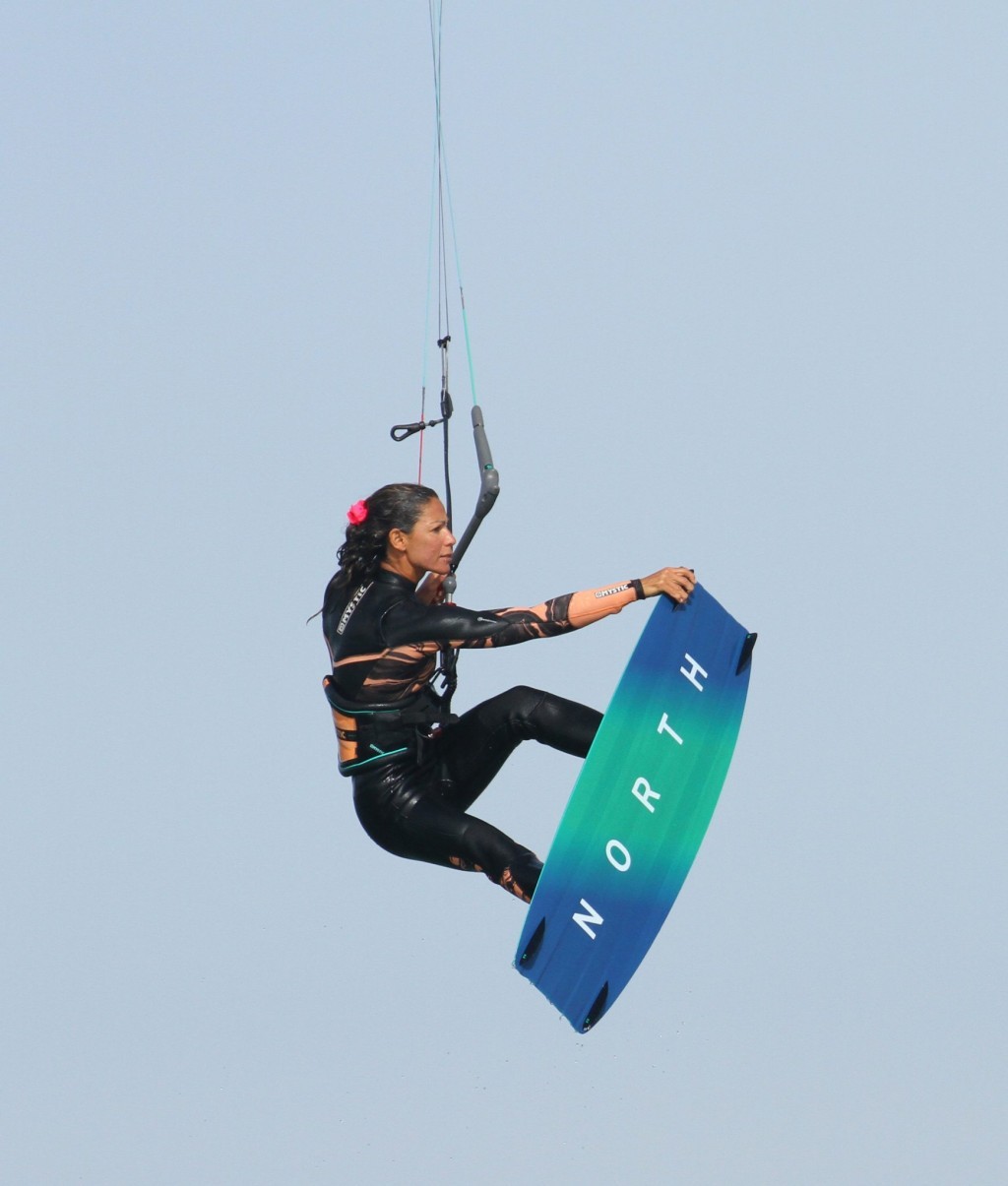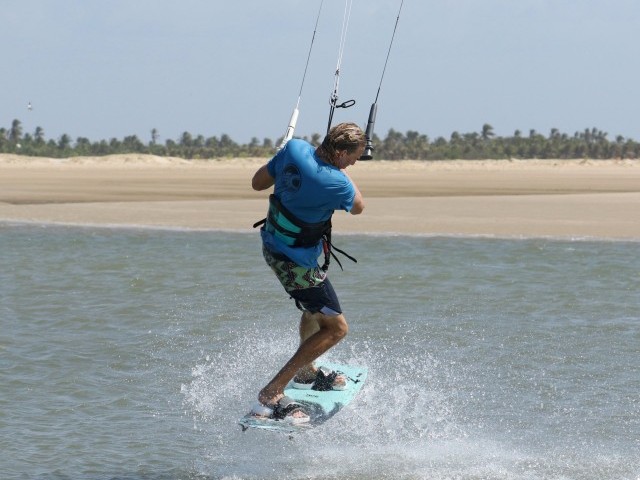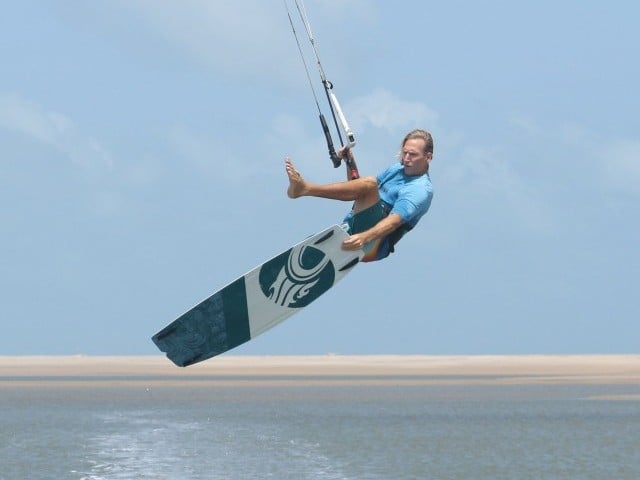
Back Loop Double Grab
Technique / Intermediate
Introduction
Hard to believe, it’s more than two years ago that we took you through the Front Roll with two grabs! Time to rectify the situation. So here it is, a sent back loop/roll spiced up with both a nose and a tail grab. A must for your aerial repertoire, double embellishments ooze style points. Prerequisites for this are an ability to boost a back roll, preferably with a controlled rotation. And if you happen to be in the business of nose and tail grabs during straight jumps, it’ll certainly speed things up. To make your life easier, let us start proceedings off with an in-depth look at the crucial parts of this beauty...
Approach and Take Off Pic A.
First off, this is a sent jump with a back rotation. This means that your approach should be as per a jump. Kite no higher than 1 or 11 o’clock, a solid edge upwind, resisting with your back leg and as much edge in the water as possible. Add to this a decent sending of the kite, and it’s game on. This approach will help a couple of things. You need time in the air to squeeze in the double grab, and you want a slow, balanced rotation. This isn’t about going orbital, but you want support from the kite throughout. With the kite no higher than the 11 marks, you’ll be able to get enough height and time with a good send, without the danger of the kite flying too far behind. That said you do want the kite to go past 12 o’ clock. With the kite slightly behind you, you’ll be both more balanced, and it will help with a slower rotation, which is crucial to the success of this move. You can see that Karine has a good edge, her weight is centred, and she is driving against her back foot, with her back leg quite extended and bum close to the water. This equals plenty of edge in the water and lots of resistance. With her kite just below 11 o’clock, she has given the bar a solid send on the sweet spot, so that she’ll get the lift before the kite travels too far. Her hands are centred on the bar in preparation of the grabs.
Go and Slow Pic B.
As you lift off, there’s a bit of multi-tasking required to set all the pieces in motion. You need to kick up off your back leg, which will stop you from rolling back (hence why it’s a back loop not a back roll;) and will keep you in control of the bar. This kick will also offer you some rotation as you carve up into the wind, as well as helping you up into the air. While the temptation is to throw your head around and look over your shoulder to help the rotation, you must resist the urge. Spinning uncontrollably around won’t give you any balance, time or confidence to look for the grabs. As you carve up, keep your head looking forwards, perpendicular to your shoulders.
Last but not least you need to stop the kite going any further back, by levelling the bar. You can see in the pic that Karine has a fully extended back leg as a result of her kicking off, her head is looking forward towards her bar, and she has levelled the bar by pulling in on her front hand. These combined parts lead to a positive take-off; a lifting kite stopped behind 12 o’ clock and the very slow initiation of a back rotation.
Spot and Stop Pic C.
Here is the reason the slow rotation is required, as you will effectively stall your back rotation so that you can get both grabs in while both feeling and being in control! If you’ve sent yourself into a whirlwind twister spin, you’ll struggle for sure. This is no different from learning any grab or combo, make sure that everything is where it should be first while you still have two hands for control, and only then do will you reach for the tickle. First, with both hands on the bar, you should ponder your nose grab. The movement is to bring your front knee up and across in towards your chest on the back hand side, while extending the back leg, to push the tail away, which will point the nose up towards you. If you look towards the nose, where you’d like to grab, you will be looking upwind, against your rotation. And with the kite hanging obediently just behind 12, you’ll come to a standstill, or at least slow down noticeably! Karine is looking towards the nose; her head is re-winding back against her rotation, slowing her down. At the same time, she is lifting her front knee and extending her back leg.
Grab 1 – The Nose Pic D.
If your take-off and stall go well, the resulting control should make this bit achievable. In comparison to the last picture, the only thing that has changed is the angle of the board as Karine has positioned it perfectly with her legs, nose high, tail low, which allows for an extended back arm grab of the nose. While doing this, Karine keeps tension on the lines, her bar is in on the sweet spot, and with her front hand centred the kite shouldn’t be moving too much. Yet again, with the kite positioned behind 12 o’ clock, it gives her room for error should the kite starts to move forwards once she grabs.
Drop and Swap Pic E.
Once you’ve had a good tickle of the nose and made it count you should think about swapping out for the next grab. Your main concern here is the position of the kite. If you feel that it is already pulling you forwards, you don’t have time. If you feel that you’re dropping and it’s too far back, you need to steer it above you. However, your aim is like on any other grabbed jump, a smooth, progressive natural movement of the kite while grabbing. Assuming it’s above and still floating you, drop the nose and swap your legs. That is to say, bring your back leg up as you extend and bone your front leg out. Keep looking at the board so that you don’t rotate yet. You can see Karine has dropped the nose and “swapped” her legs, her bar is in, and she’s looking at the board. And she still hasn’t rotated.
Grab 2 – The Tail Pic F.
Having already had the board in your sights, as soon as you go for the grab, you also need to get your rotation back on track. Feel for the tail of the board or the fin and then turn your head to look downwind. This is also the time to get the kite ready for later part of your rotation. If you get it moving forwards through 12, the kite’s pull on your harness will help you turn the rest of the way. As Karine grabs, she’s steering the kite forwards and starts to turn her head back towards her front shoulders.
The Dive Pic G.
All good things must come to an end, but to squeeze the most out of this move, you should try and hold the tail grab for as long as possible. This means getting your return to earth underway while still having your back hand anchored to the board. Once you feel that you’re on the way down and approaching the wet stuff, you must dive the kite hard so that it will pull you out of your rotation and towards it for a smooth downwind landing. Here Karine is still holding the tail while diving the kite hard with her front hand. She can then release her grab just before touch down, placing the tail of the board down first for a smooth reception.
Top Tips
Progressive steps will make life less complicated! May we suggest starting with a few slow rotation Back Loops/Rolls. Much easier to nail your slow leading take off without having to concentrate on a grab or two.
Once you’ve got the slow rotation in the back, work on the grabs separately. For the nose grab, work on getting it early, and while stalling your rotation. Then move onto only the tail grab, again with the slow rotation, but now holding the grab for as long as possible to get the one-handed dive for landing sorted.
Finally, marry the stages above into one happily flowing bundle of joy...
Now have a good look at the sequence and videos to get a real-time look into your next move.
Common Problems
If you find you don’t have enough time in the air, you’re either too gentle with your kite send, coming in too slowly or a mixture of both. Make sure you have enough speed and tension to jump and make sure your kite is no higher than 11 or 1 o’clock.
If your kite is flying too far back in the window once you take off if you don’t kick-off, but compress, you will roll back, and the kite will go too far back. Make sure you resist, kick and level the bar even before take-off. Or you may be starting with your kite too high, so get it down a tad.
If you’re missing the grabs, make sure you’re rotating slowly on take-off, and perhaps go and practice them separately.
If you come down nose heavy, you are moving your kite across 12 too early, so leave it back until you’ve got the tail grab.
If you’re getting the grabs but not finishing the rotation, make sure to turn your head as you bring the kite over.
Keystones
- Solid edge and decent send, kick up and level bar
- No head, slow rotation
- Front knee up and across for nose grab
- Drop and swap for tail
- Turn head and dive for landing
This technique article was in Issue 76 of IKSURFMAG.
Related
By Christian and Karine
Christian and Karine have been working together as a coaching team, running improver to advanced kitesurfing clinics since 2003.




























